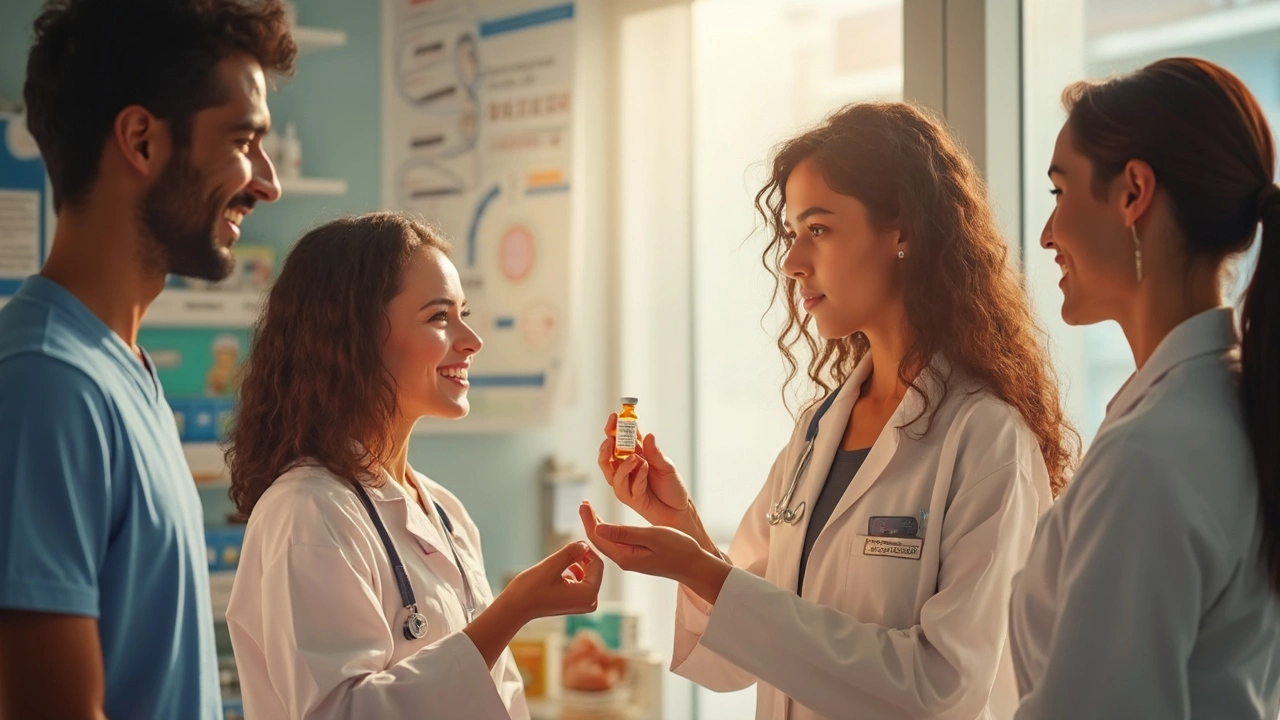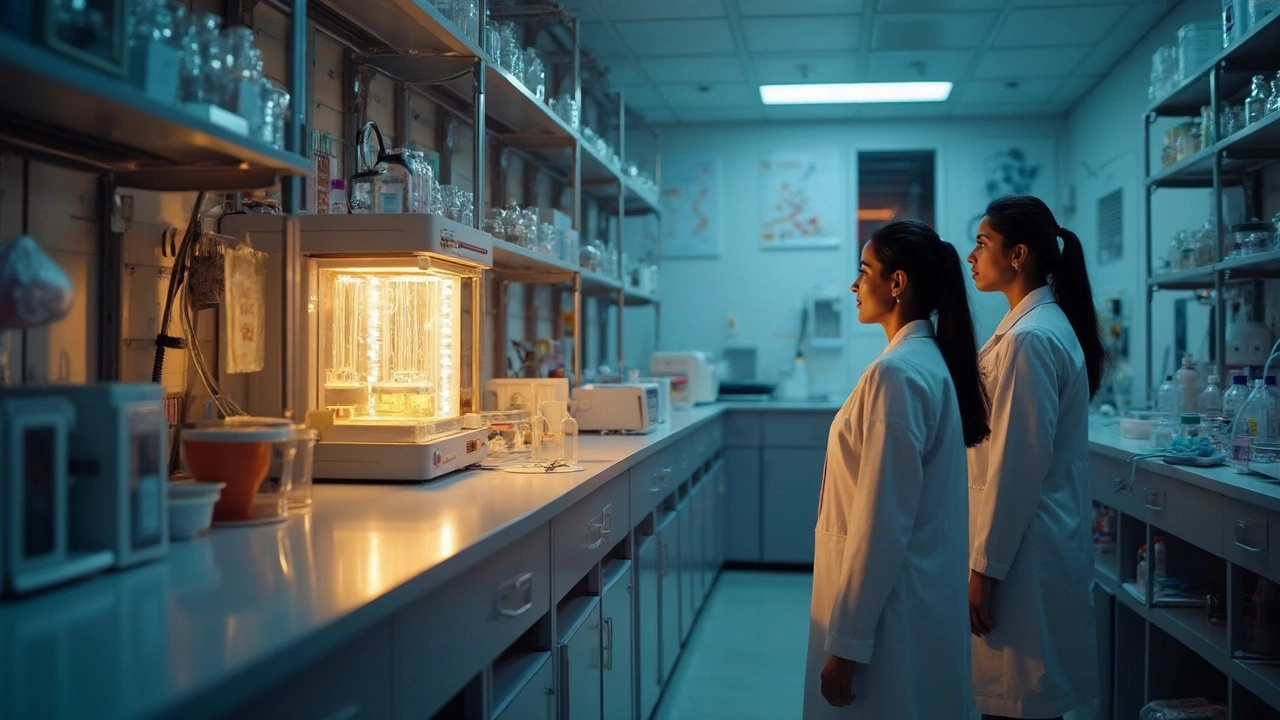Biotechnology Example: How Insulin Changed Diabetes Care
 May, 2 2025
May, 2 2025
Imagine living with diabetes before the 1980s. Getting insulin meant using stuff taken from cows or pigs—and your body could freak out because animal insulin wasn’t a perfect match. If you’ve seen people prick their finger for a drop of blood or carry around tiny vials, you’re looking right at biotechnology’s fingerprints on real life.
So, what flipped the script? Scientists figured out how to “teach” bacteria to make human insulin in the lab. No more animal stuff, just a perfectly matched medicine. That tiny breakthrough didn’t just make life easier. It made life longer and safer for millions of people—all thanks to biotech.
If you’ve ever wondered what biotechnology looks like outside a science lab or a sci-fi movie, just look at any pharmacy shelf stocked with insulin pens. This story isn’t about gadgets or robots. It’s real, everyday proof that science can solve tricky problems in ways most of us never imagine.
- The Problem with Old-School Insulin
- How Scientists Turned Bacteria Into Insulin Factories
- Everyday Impact for Diabetes Patients
- Cool Facts and Tips About Biotech Solutions
The Problem with Old-School Insulin
Before biotechnology showed up, managing diabetes was pretty tough. Back then, insulin didn't come from humans—it came from cows and pigs. That sounds weird, but for years, it was the only way people with diabetes could survive. These animal-based insulins helped, but they were not identical to human insulin. This caused all sorts of problems.
The weirdest part? Sometimes people’s bodies recognized this animal insulin as something foreign. They could develop allergic reactions, build resistance, or see their blood sugar levels swing up and down unexpectedly. According to the CDC, by the 1970s, more than a million Americans depended on animal insulin—and many of them had a tough time getting consistent results.
“Animal-sourced insulin saved lives, but it was always a compromise. People had to deal with side effects and short supplies,” said Dr. Daniel DeSalvo, Diabetes Care Specialist at Baylor College of Medicine.
Besides awkward side effects, getting enough animal insulin wasn’t easy. The world needed huge numbers of animals to meet demand. For example, making one batch large enough for just a dozen people for one year could take insulin from over 50 cows or pigs. That’s a crazy supply chain and never enough to keep up as diabetes cases rose.
- The process was expensive and time-consuming.
- Shortages were common, especially in places without access to big farming operations.
- Quality was inconsistent—some batches just worked better than others.
So by the late 1970s, not only were doctors and patients frustrated, but the world basically hit a wall: animal insulin was not a long-term answer. That’s when biotechnology started to grab everyone’s attention. People were desperate for a better, safer, more reliable solution to treat diabetes.
How Scientists Turned Bacteria Into Insulin Factories
The whole game-changer started in the late 1970s. Back then, researchers wanted a better way to make human insulin—something that didn't rely on animals. Enter genetic engineering, the core magic behind modern biotechnology. Two companies, Genentech and Eli Lilly, led the charge.
Here's the clever bit: scientists took the human gene that tells your body how to make insulin and actually stuck it inside a bacterium, usually E. coli. This wasn’t science fiction. It worked because bacteria are tiny but mighty—they grow fast and make loads of whatever you program into their DNA.
- Step 1: Scientists cut out the DNA part responsible for insulin from human cells.
- Step 2: They used enzymes (tiny molecular scissors) to snip the DNA and “glue” it into a circular piece of DNA called a plasmid.
- Step 3: That plasmid, containing the insulin recipe, went into a bacterium.
- Step 4: The bacteria started cooking up human insulin, which could be harvested, cleaned, and sold as medicine.
Fun fact: The first FDA-approved insulin made this way—Humulin—hit the shelves in 1982. Before then, animal insulin sometimes triggered bad immune reactions. Bioengineered insulin was not just safer but also way more reliable, especially during shortages.
| Year | Event |
|---|---|
| 1978 | First synthetic human insulin created in the lab |
| 1982 | Humulin becomes FDA approved |
So next time you see a vial or an insulin pen at the pharmacy, that’s not just medicine—it’s bacteria-powered, lab-made insulin, made possible by everyday science and a boost from biotechnology.

Everyday Impact for Diabetes Patients
Think about managing diabetes today compared to forty years ago: it’s a total game-changer. Thanks to biotechnology, people with diabetes can use insulin that’s made to match the human body. This means fewer bad reactions and more reliable blood sugar control. The old days of pig or cow insulin—and the side effects like allergic reactions—are mostly gone.
It’s not just about fewer side effects. Synthetic or "recombinant" insulin gives way more flexibility. People can now use different types: some act fast, others work slowly. That lets each person (and their doctor) pick what fits their day—like having a meal and needing insulin to work quickly, or taking one shot that lasts all night. All this helps keep blood sugar closer to normal, which means fewer scary lows or long-term problems like kidney and heart disease.
Check this out—the International Diabetes Federation says there are over 540 million adults with diabetes worldwide. Making enough insulin with animals just isn’t possible for those numbers. Thanks to biotechnology and those insulin-making bacteria, there’s enough medicine for everyone who needs it. And it’s safer, too, because scientists can make every batch exactly the same. No more guessing or hoping your next refill is just like the last.
| Year | How Insulin Was Made | Number Helped |
|---|---|---|
| 1975 | Animal Pancreas | Less than 5 million |
| 2025 | Recombinant DNA (Biotech) | Over 30 million* |
*Just people using insulin. Millions more benefit from other biotech diabetes tools.
So, the next time you spot an insulin pen or see a TV ad for diabetes medicine, remember you’re actually seeing real life biotechnology at work. And for people living with diabetes, it means more freedom, fewer worries, and a much better shot at a healthy life.
Cool Facts and Tips About Biotech Solutions
Think of biotechnology as a toolbox for solving health issues. Sometimes it's subtle, like that insulin shot that looks just like any other medicine. Other times it's eye-popping, like gene editing or lab-grown meat. Here are some facts you might not know, plus a few tips that could actually help if you or someone you care about uses biotech-based stuff.
- Human insulin was the very first drug made with genetic engineering. It landed on the market way back in 1982, which was honestly a game-changer for anyone living with diabetes.
- Biotech-made insulin cuts down allergy risks and works more predictably than animal-based versions. It's not just hype—studies tracked lower side effects and better blood sugar control after the switch.
- Over 400 million people worldwide count on biotech-made insulin or other advanced diabetes tech every single day. That’s a huge chunk of the planet depending on biotechnology advances just to stay healthy.
- It’s not just insulin. Other biotech meds for things like cancer, arthritis, and even rare blood diseases are made using similar lab tricks. Medicines called "biologics" are usually made by engineering living cells to crank out the actual drug.
- Watch for generic versions of biotech meds—called "biosimilars"—to save money. They're not quite the exact same as generic pills, but they can be a lot cheaper and just as safe.
If you’re getting a new prescription and the price tag looks scary, ask your doctor or pharmacist whether there’s a "biosimilar" available. These days, major pharmacies and health systems have info on which biotechnology meds are covered by insurance.
| Biotech Product | Main Use | Year Introduced |
|---|---|---|
| Recombinant Insulin | Diabetes management | 1982 |
| Filgrastim | Boosts white blood cells (chemo support) | 1991 |
| Trastuzumab (Herceptin) | Breast cancer treatment | 1998 |
Before you try any biotechnology product, always double-check how you’re supposed to use it. Some meds need to be kept cool or handled just so—something as simple as skipping a fridge can mess up the dose. If your treatment gets changed from a brand to a biosimilar, don't panic. Docs and pharmacists are used to this and will give you the real talk about what’s different (usually, almost nothing you’ll notice).